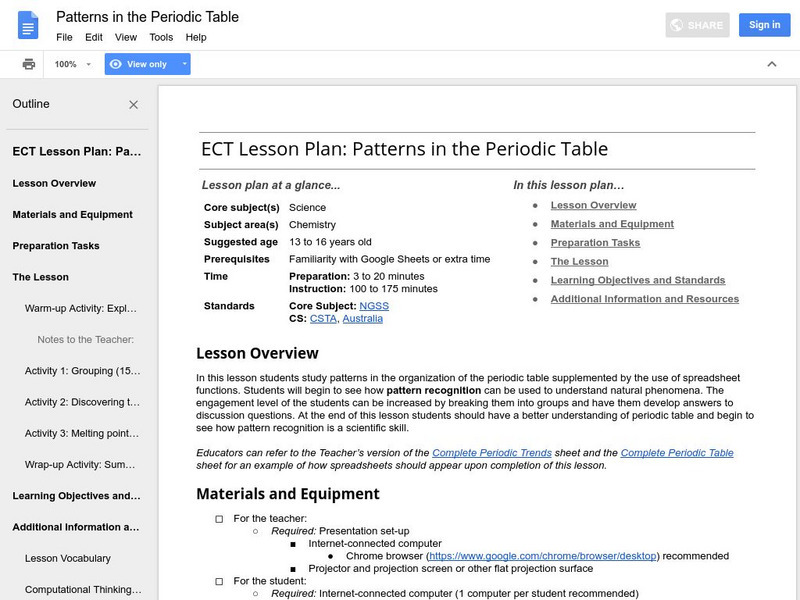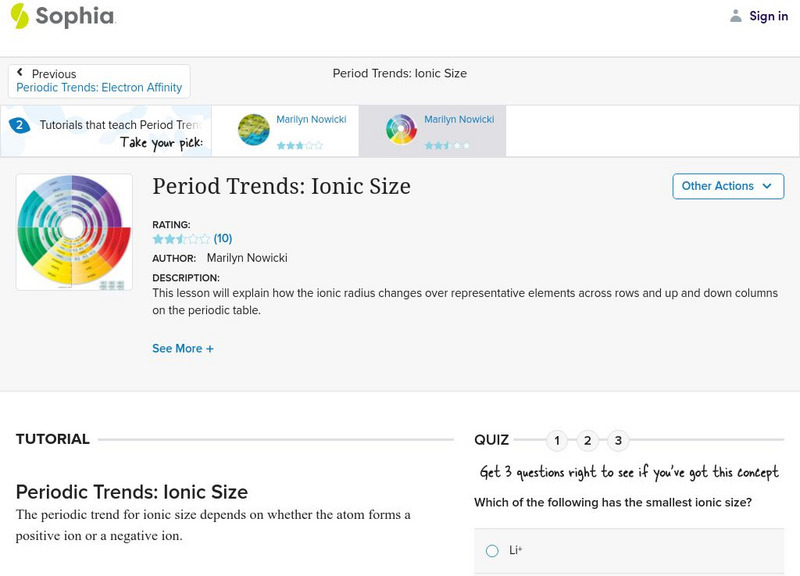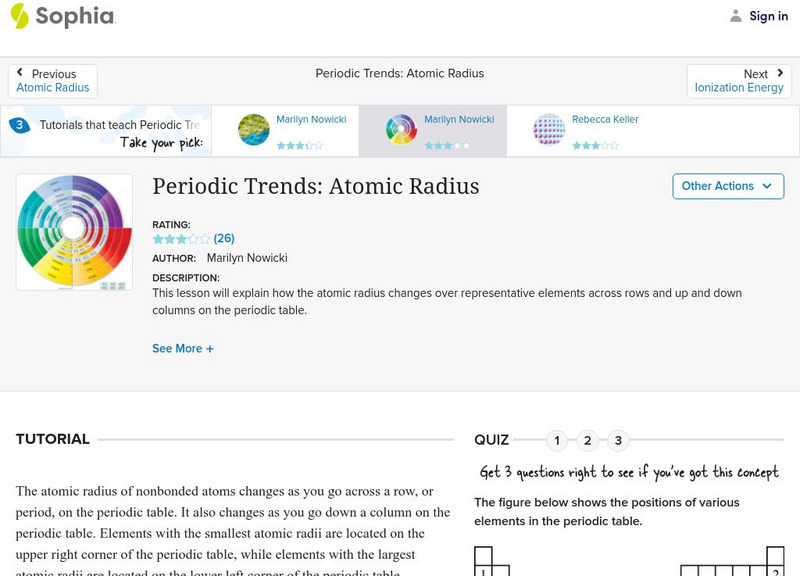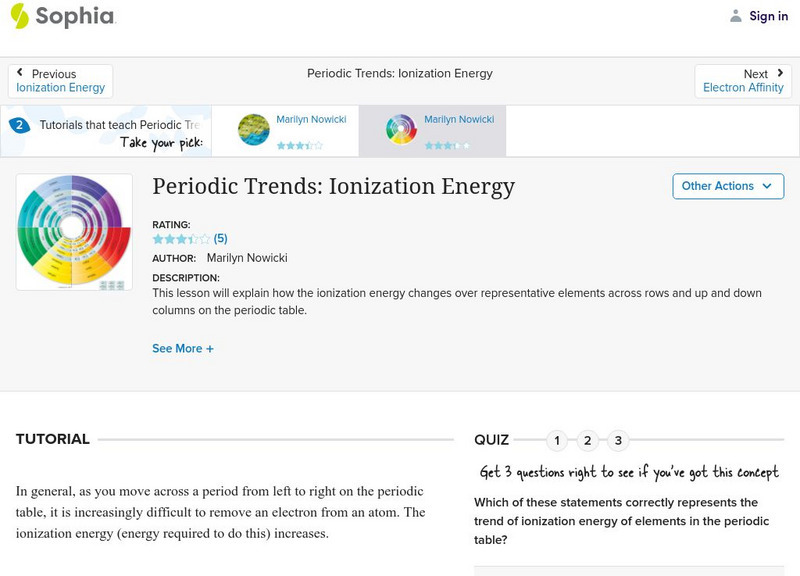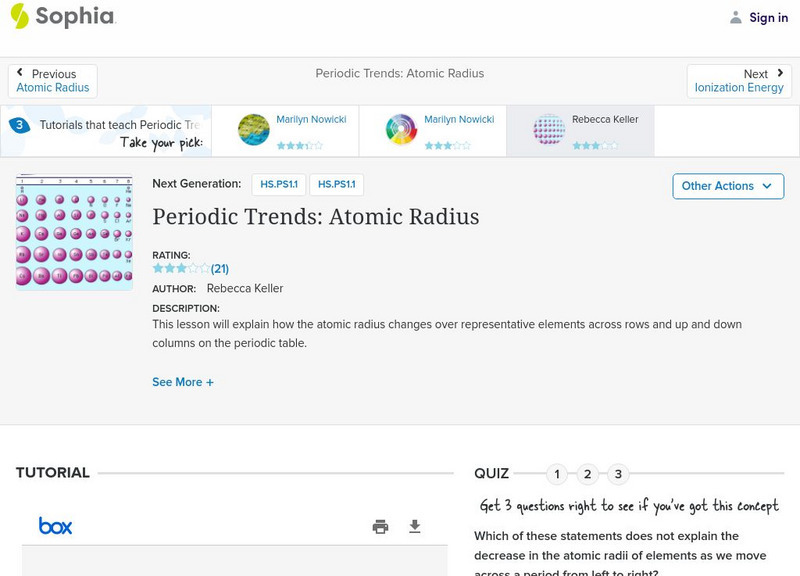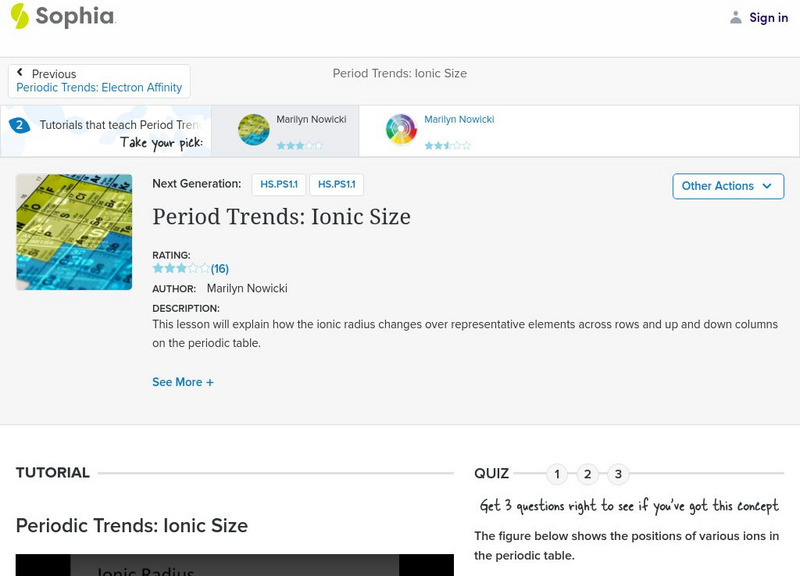Google
Google for Education: Patterns in the Periodic Table
Students study trends in the periodic table of elements, supplemented by the use of spreadsheet functions. The spreadsheet functions presented can be used on any data set.
Google
Google for Education: Example: Patterns in the Periodic Table
A lesson plan where students examine the trends in the periodic table.
Science Education Resource Center at Carleton College
Serc: Valence Electrons and Trends in the Periodic Table
This instructor led activity will produce a partially filled periodic table that contains electron-dot models for the first twenty elements in the appropriate boxes. It will be used as a visual tool for learners to connect concepts such...
Other
Dynamic Periodic Table
Using this interactive Periodic Table of Elements, learners can view real-time data, dynamically change layouts, visualize trends, and see a 3-D view of orbitals. The names of elements are available in dozens of different languages....
CK-12 Foundation
Ck 12: Periodic Trends
[Free Registration/Login may be required to access all resource tools.] In the following online tutorail students will use the Periodic Table to identify and explain periodic trends, including atomic and ionic radii, electronegativity,...
Science Education Resource Center at Carleton College
Serc: Trends on the Periodic Table: Metals, Non Metals, and Metalloids
In this lab activity, students will be asked to observe and then test the physical and chemical properties of several different elements.
Sophia Learning
Sophia: Period Trends: Ionic Size: Lesson 3
This lesson will explain how the ionic radius changes over representative elements across rows and up and down columns on the periodic table. It is 3 of 3 in the series titled "Period Trends: Ionic Size."
Sophia Learning
Sophia: Periodic Trends: Atomic Radius: Lesson 3
This lesson will explain how the atomic radius changes over representative elements across rows and up and down columns on the periodic table. It is 3 of 3 in the series titled "Periodic Trends: Atomic Radius."
Sophia Learning
Sophia: Periodic Trends: Ionization Energy: Lesson 3
This lesson will explain how the ionization energy changes over representative elements across rows and up and down columns on the periodic table. It is 3 of 3 in the series titled "Periodic Trends: Ionization Energy."
Sophia Learning
Sophia: Periodic Trends: Atomic Radius: Lesson 2
This lesson will explain how the atomic radius changes over representative elements across rows and up and down columns on the periodic table. It is 2 of 3 in the series titled "Periodic Trends: Atomic Radius."
Georgia Department of Education
Ga Virtual Learning: Ap Chemistry: Atomic Theory
In this module students explore how matter is classified, the history of atomic theory, subatomic particles, modern atomic theory, electron configuration, the periodic table and its trends, and spectroscopy.
Texas Instruments
Texas Instruments: Setting the Trend
In this activity you will - Determine the trend in atomic radius for the periodic table. Determine the trend in first ionization energy for the periodic table. Determine the trend in electronegativity for the periodic table.
CK-12 Foundation
Ck 12: Chemistry: Electron Affinity
[Free Registration/Login may be required to access all resource tools.] Covers the definition of electron affinity and trends in electron affinity.
Sophia Learning
Sophia: Periodic Trends: Atomic Radius: Lesson 1
This lesson will explain how the atomic radius changes over representative elements across rows and up and down columns on the periodic table. It is 1 of 3 in the series titled "Periodic Trends: Atomic Radius."
Sophia Learning
Sophia: Periodic Trends: Electron Affinity: Lesson 3
This lesson will explain how the electron affinity changes over representative elements across rows and up and down columns on the periodic table. It is 3 of 3 in the series titled "Periodic Trends: Electron Affinity."
Sophia Learning
Sophia: Period Trends: Ionic Size: Lesson 1
This lesson will explain how the ionic radius changes over representative elements across rows and up and down columns on the periodic table. It is 1 of 3 in the series titled "Period Trends: Ionic Size."
Wikimedia
Wikipedia: Electronegativity
This encyclopedia article from Wikipedia gives a definition for what electronegativity is, information on the two scales of electronegativity that are in common use (Pauling and Mulliken Scales), and a discussion on electronegativity...
Curated OER
Effective Nuclear Charge Periodic Trends
Acting as a subtopic of the General Chemistry Virtual Textbook's section on Atoms and the Periodic Table, this site discusses the properties of the atoms individually in relation to the main group elements of the Periodic Table.
Curated OER
Covalent Atomic Radii Periiodic Trends
Acting as a subtopic of the General Chemistry Virtual Textbook's section on Atoms and the Periodic Table, this site discusses the properties of the atoms individually in relation to the main group elements of the Periodic Table.
Curated OER
Ionic Radii Periiodic Trends
Acting as a subtopic of the General Chemistry Virtual Textbook's section on Atoms and the Periodic Table, this site discusses the properties of the atoms individually in relation to the main group elements of the Periodic Table.
Curated OER
Ionization Energies Periiodic Trends
Acting as a subtopic of the General Chemistry Virtual Textbook's section on Atoms and the Periodic Table, this site discusses the properties of the atoms individually in relation to the main group elements of the Periodic Table.
Curated OER
Electron Affinities Periiodic Trends
Acting as a subtopic of the General Chemistry Virtual Textbook's section on Atoms and the Periodic Table, this site discusses the properties of the atoms individually in relation to the main group elements of the Periodic Table.
